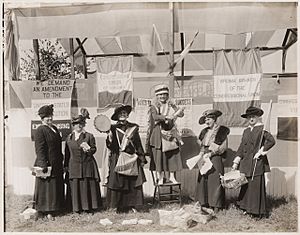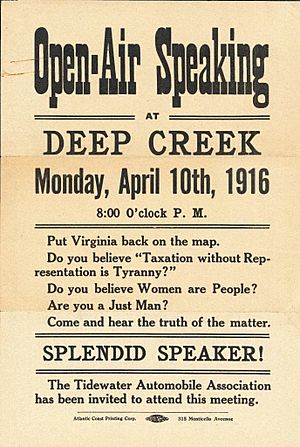Timeline of women's suffrage in Virginia facts for kids
This is a timeline showing when women in Virginia worked to get the right to vote. While some people started talking about women's voting rights very early on, most of the big actions happened in the early 1900s. Groups like the Equal Suffrage League of Virginia (started in 1909) and the Virginia Branch of the Congressional Union for Woman Suffrage (which later became the National Woman's Party, started in 1915) led the way.
Over the years, women held many meetings and rallies. They also tried to pass laws in the Virginia General Assembly to let women vote. However, Virginia didn't officially approve the Nineteenth Amendment (which gave women the right to vote across the U.S.) until 1952. Also, Native American women couldn't fully vote until 1924. And many African American women faced unfair rules that stopped them from voting until the Voting Rights Act was passed in 1965.
Early Efforts for Women's Vote
The 1700s: A Voice for Fairness
1778
- Hannah Lee Corbin from Gloucester County spoke out. She believed it was wrong for women to pay taxes if they couldn't vote for the people who made the tax laws. This idea is called "taxation without representation."
The 1800s: Starting to Organize
1870
- The Virginia State Woman Suffrage Association (VSWSA) was created by Anna Whitehead Bodeker. This was one of the first groups in Virginia focused on women's voting rights.
1871
- November: Anna Bodeker bravely tried to vote in a local election in Virginia.
1893
- The Virginia Suffrage Society was formed by Orra Gray Langhorne. More groups meant more voices pushing for change.
1895
- Susan B. Anthony, a very famous leader for women's voting rights, gave a speech in Culpeper. Her visit helped inspire more people in Virginia.
The 1900s: A New Century of Action
The Early 1900s: Building Momentum
1900
- Carrie Chapman Catt, another important national leader, encouraged Virginia to let women vote during a meeting about the state's rules.
1902
- Virginia made new rules that stopped many people from voting. This included African Americans, poor white people, and Republicans. Voters now had to pass a literacy test (show they could read and write) and pay a poll tax (a fee to vote). These rules made it very hard for many people to cast their ballots.
1909
- November 27: The Equal Suffrage League of Virginia was officially started at the home of Anne Clay Crenshaw. This group became very important in the fight for women's votes in Virginia.
The 1910s: Rallies, Marches, and New Groups
1910
- February: The Equal Suffrage League of Virginia joined forces with the National American Woman Suffrage Association (NAWSA). This connected their local efforts to a bigger national movement.
1911
- The first statewide meeting for women's voting rights was held in Richmond. People came from cities like Norfolk, Lynchburg, and Williamsburg.
1912
- February: Lawmakers in the House of Delegates said no to changing the state's rules to allow women to vote.
- July: The National Association of Colored Women (NACW) held their meeting in Hampton. They discussed women's voting rights, and women's clubs from Hampton and Norfolk even held a parade!
- The Virginia Association Opposed to Woman Suffrage was formed. This group worked against women getting the right to vote.
- The Men's Equal Suffrage League of Virginia was formed. This showed that not just women supported the cause.
- A proposal for women's voting rights was brought up in the Virginia General Assembly by Hill Montague.
1914
- March: Again, the House of Delegates rejected the idea of letting women vote.
- May 2: A big demonstration for voting rights was held on the steps of the Virginia State Capitol.
- October: A monthly newspaper called the Virginia Suffrage News was started. It shared news and ideas about the movement.
1915
- From May until Thanksgiving, women held "street meetings" in many cities. They talked to people directly about why women should vote.
- May 1: A fun May Day celebration was held at the Capitol building. Supporters sold buttons, flags, and copies of the Woman's Journal to raise awareness.
- June 10: The Virginia Branch of the Congressional Union for Woman Suffrage was organized in Richmond. Sophie G. Meredith was its first leader.
- December: About 200 people marched to the governor's office during a meeting in Richmond.
1916
- February: The House of Delegates once again voted against letting women vote.
- October: A brave pilot named Katherine Stinson flew over the Virginia State Fair. She dropped leaflets about women's voting rights from her plane!
- A third proposal for women's voting rights was brought up in both the House and Senate.
1917
- January 29 – February 2: A "suffrage school" was held in Richmond with the help of NAWSA. This was a training program for activists.
- November 15: The Night of Terror happened at the Occoquan Workhouse. This was a harsh event where women who were protesting for the right to vote were treated very badly.
- December: Virginia sent the largest group of supporters to the national meeting in Washington, D.C.
1919
- August 13: The General Assembly had a special meeting. Women used this time to find out where politicians stood on women's voting rights.
The 1920s: The Vote is Won, But Not for Everyone
1920
- February 12: The Virginia General Assembly voted against officially approving the Nineteenth Amendment.
- August 26: Even though Virginia didn't approve it yet, the Nineteenth Amendment was officially passed for the whole country! This meant women across the U.S. could now vote.
- September: The Equal Suffrage League of Virginia changed its name and became the League of Women Voters (LWV) of Virginia. This new group focused on helping people vote and understand politics.
- September 2 – October 2: Between 75,000 and 100,000 white and African American women in Virginia signed up to vote for the first time!
- November 10: The League of Women Voters of Virginia held its first meeting.
1924
- Native American women in the United States were finally given the right to vote.
The 1950s: Virginia Catches Up
1952
- February 21: Virginia finally approved the Nineteenth Amendment, many years after it became law for the rest of the country.
The 1960s: Voting Rights for All
1965
- The Voting Rights Act was passed. This very important law helped end unfair rules that stopped African American women (and men) from voting. It was a huge step towards making sure everyone had an equal chance to vote.




